The following information is summarized from the Northern Colorado Plateau Network monitoring plan, published in 2004. Some details may have changed.
Park History and Purpose
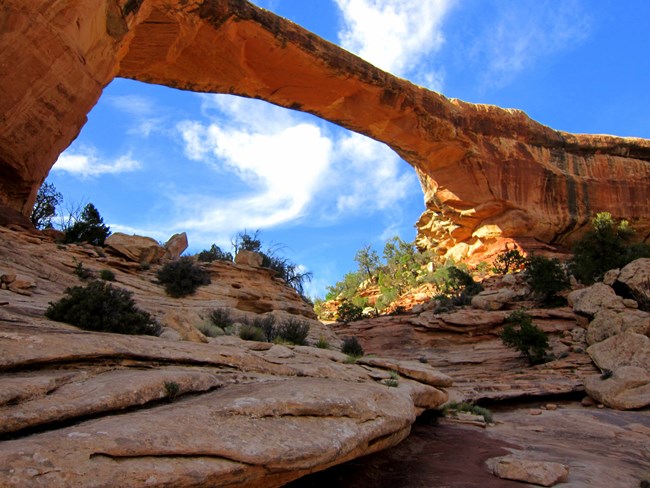
NPS/L. Gommermann
Established in 1908, Natural Bridges National Monument is Utah's oldest National Park Service unit. A total of 49 hectares (120 acres) were originally set aside around each of three bridges based on President Theodore Roosevelt's original Proclamation No. 804, April 16, 1908, 35 Statute 2183. The main purpose was stated as, "Whereas, a number of natural bridges situated in southeastern Utah having heights more lofty and spans far greater than any heretofore known to exist, are of the greatest scientific interest, and it appears that the public interests would be promoted by reserving these extraordinary examples of stream erosion with as much land as may be necessary for the proper protection thereof..."
Later, the monument was enlarged to 979 hectares (2,420 acres) containing the three bridges, prehistoric structures, and cave springs, as stated in President William H. Taft's Proclamation No. 881, September 25, 1909, 36 Statute 2502, "...at the time this Monument was created nothing was known of the location and character of the prehistoric ruins in the vicinity of the bridges, nor of the location of the bridges and prehistoric cave springs, also hereby reserved..."
The same area was resurveyed, and set aside by President Woodrow Wilson's Proclamation No. 1323, February 11, 1916, 39 Statute 1764, "...whose purpose is to conserve the scenery and the natural and historic objects and the wild life therein and to provide for the enjoyment of the same in such manner and by such means as will leave them unimpaired for the enjoyment of future generations."
In August 1962, President John F. Kennedy's Proclamation No. 320 withdrew 320 acres around Snow Flat Spring Cave and Cigarette Spring Cave since these caves, "...no longer contain features of archeological value and are not needed for the proper care, management, protection, interpretation, and preservation of the Monument." This proclamation expanded the Monument, reiterated the public and scientific communities' interest in preservation and protection of the bridges and prehistoric sites, and set forth management objectives.
Location
In San Juan County, Utah, 193 kilometers (120 miles) south of Moab, Utah, accessible via Utah Highway 95, which connects Blanding, Utah with Hanksville, Utah. Blanding, Utah (population 3,100) is the nearest population center, located 64 kilometers (40 miles) east. The surrounding area (San Juan County) is sparsely populated, with a density of less than 1.5 people per square mile (0.6 people per square kilometer). The surrounding area has never been settled by Anglos and has been used only for extensive livestock grazing and minor mining activities.
Elevation
Elevation varies from approximately 1,738 meters (5,700 feet) in the canyons to 1,951 meters (6,400 feet) on the rims.
Size
3,009 hectares (7,435 acres)

NPS/Jacob W. Frank
General Description
Nowhere else are three such extraordinary natural bridges found in such close proximity. These three bridges show three different stages of development, from youth (Kachina), to maturity (Sipapu), to old age (Owachomo). Together with their canyons, these three bridges are excellent examples of an entrenched meander stream system.
Natural Bridges National Monument was also created for the presence of three well-preserved structural sites and a range of archaeological sites, from Archaic through historic times.
A high-desert riparian environment, combined with a perennial supply of standing water (the result of numerous seeps), creates a unique biological climate where relict species (e.g., Douglas-fir) remain and moist alcoves shelter hanging-garden communities. Here, rare plants (such as the kachina daisy) find refuge, and other water-loving flora thrive in riparian corridors that provide food, shelter, and travel for wildlife. The monument provides a breeding ground for peregrine falcons, is home to at least 15 bat species, and is surrounded by extensive public lands that are candidates for Wilderness designation.
Pristine air quality ensures extensive vistas and, combined with the absence of artificial light, provides outstanding opportunities to view night skies. The absence of human-generated sound leaves visitors to enjoy natural silence—a hallmark of canyon country.
Natural Bridges National Monument was also established to preserve outstanding Ancestral Puebloan cultural remains. Cultural resources are outstanding and provide the opportunity to study interactions among indigenous cultural groups. Numerous sites exist with religious and historical significance to American Indians.
The monument preserves one of the few locations of the very rare kachina daisy (Erigeron kachinensis), and an outstanding example of an ephemeral desert stream. The ecological processes and biological diversity found here are found in few other places.
Two major canyons, White and Armstrong, are deeply incised into the Cedar Mesa sandstone. The vegetation is predominately pinyon-juniper woodland, a vegetation type common to most of southeast Utah at elevations of 1,220 to 2,440 meters (4,000 to 8,000 feet). Riparian vegetation occupies the surface water drainages, and small pockets of Douglas-fir and associated mesic vegetation grow in sheltered areas along canyon rims. Common large mammals include mule deer, coyote, and desert cottontail. Conspicuous birds are the common raven, turkey vulture, red-tailed hawk, and scrub jay. A variety of lizards can be seen during the warmer months, along with a large population of midget prairie rattlesnakes.
Plants and Animals
Visitors may encounter a wide range of native and nonnative plant and animal species throughout the site.
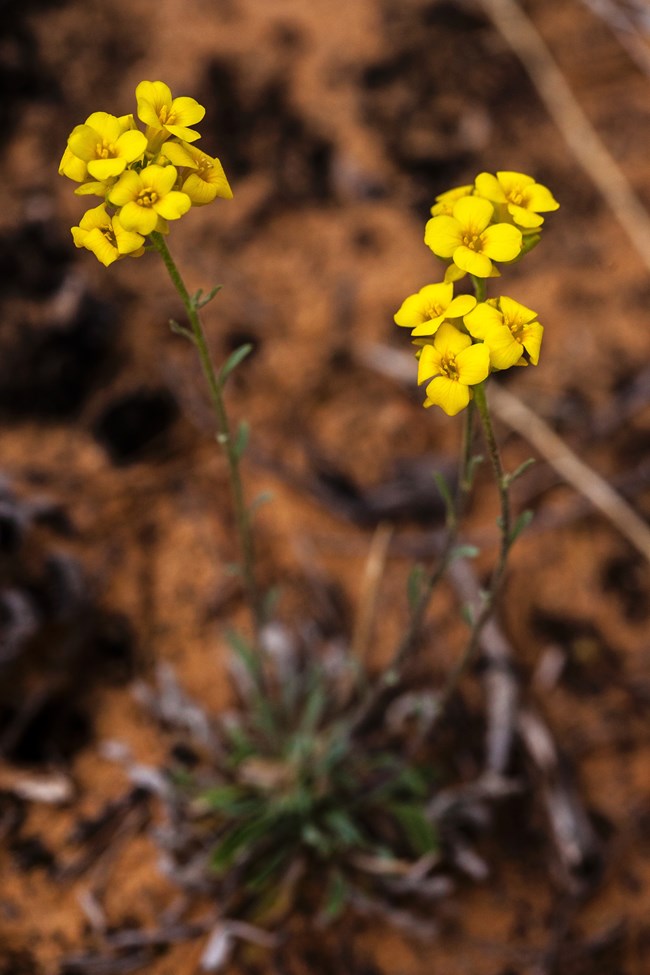
NPS/Jacob W. Frank
Flora
The monument’s flora database contains over 400 species. Vegetation is divided into five communities.
Pinyon-Juniper Community
This community is the most extensive vegetation type, covering approximately 1,700 hectares (4,200 acres), dominated by pinyon pine (Pinus edulis) and Utah juniper (Juniperus osteosperma). Other major shrub components are broom snakeweed (Gutierrezia sarothrae), roundleaf buffaloberry (Shepherdia rotundifolia), big sagebrush (Artemisia tridentata), and prickly pear cactus (Opuntia spp.). Common forbs are twinpod (Physaria acutifolia), lobeleaf groundsel (Senecio multilobatus), and Holboel rock cress (Arabis holboellii).
Rimrock Community
Next in coverage, this community accounts for 1,100 hectares (2,700 acres). The rimrock community is a shrub-dominated type found on the canyon rims and is of varied composition. Primary components are pinyon (Pinus edulis), Utah juniper (Juniperus osteosperma), manzanita (Arctostaphylos patula), Gambel oak (Quercus gambelii), broom snakeweed (Gutierrezia sarothrae), Utah serviceberry (Amelanchier utahensis), longflower snowberry (Symphoricarpos longifolius), and Haplopappus (Haplopappus spp.), for roughly 160 hectares (400 acres). Riparian vegetation communities are dominated by Fremont cottonwood (Populus fremontii), western sandbar willow (Salix exigua), yellow willow (S. lutea), and box elder (Acer negundo). Of the many forbs and grasses, principal species are phragmites (Phragmites communis), horsetail (Equisitum arvense), (E. laevigatum), and hairy goldenaster (Heterotheca villosa).
Douglas-Fir Relict Community
Encompassing less than 160 hectares (400 acres), the Douglas-fir community is a relict community characterized by Douglas-fir (Pseudotsuga menziesii), Utah serviceberry (Amelanchier utahensis), mountain lover (Pachystima myrsinites), dwarf mountain mahogany (Cercocarpus intricatus) and manzanita (Arctostaphylos patula).
Hanging Garden Community
The smallest vegetal component, covering less than 30 hectares (80 acres), the hanging garden vegetation type is characterized by moisture-loving plants. These include maidenhair fern (Adiantum capillus-veneris), cliff-brake (Pellaea spp.), scarlet monkey flower (Mimulus eastwoodiae), death camus (Zigadenus spp.), columbine (Aquilegia spp.) and alcove bog-orchid (Habenaria zothecina).
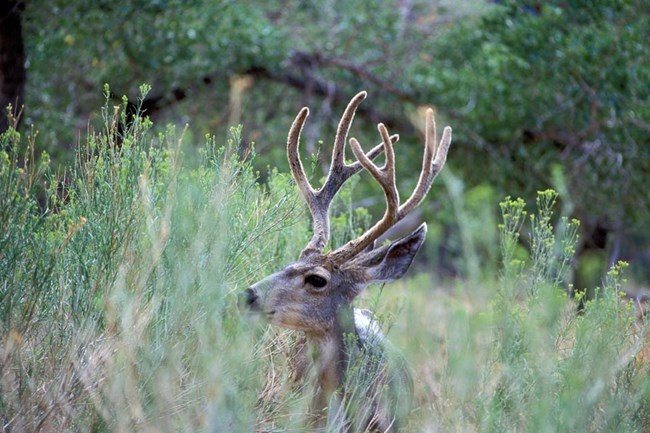
NPS/Neal Herbert
Fauna
There are approximately 172 bird species, 47 mammal species, 13 reptile species, and 7 amphibian species in the monument. There are no fish.
Mammals
Mammals were systematically surveyed from 1987 to 1994. The most common mammals are the western pipistrelle bat (Pipistrellus hesperus), coyote (Canus latrans), gray fox (Urocyon cinereoargenteus), white-tailed antelope squirrel (Ammospermophilus leucurus), Colorado chipmunk (Eutamias quadrivittatus), canyon mouse (Peromyscus crinitus), deer mouse (P. maniculatus), pinyon mouse (P. truei), desert woodrat (Neotoma lepida), porcupine (Erethizon dorsatum), black-tailed jackrabbit (Lepus californicus), desert cottontail (Sylvilagus auduboni), and mule deer (Odocoilus hemionus). The monument is considered a "hot spot" for bats on the Colorado Plateau. Of the 19 species thought to live in Utah, 15 have been captured in Natural Bridges National Monument (including the spotted bat, a candidate species for federal listing). Mountain-lion tracks are common; actual sightings are rare. Black bear visit the canyons and rim, but they are rarely seen. Desert bighorn sheep were observed prior to 1966, when the loop road was constructed. They probably still roam sections of lower White Canyon and the surrounding environs.
Birds
Common bird species are turkey vulture (Cathartes aura), northern harrier (Circus cyaneus), red-tailed hawk (Buteo jamaicensis) American kestrel (Falco sparverius), mourning dove (Zenaidura macroura), great horned owl (Bubo virginianus), common nighthawk (Chordeiles minor), white-throated swift (Aeronautes saxatalis), ash-throated flycatcher (Myiarchus cinerascens), violet-green swallow (Tachycineta thalassina), cliff swallow (Hirunda pyrrhonta), scrub jay (Aphelocoma coerulescens), pinyon jay (Gymnorhinus cyanocephalos), common raven (Corvus corax), plain titmouse (Parus inornatus), canyon wren (Catherpes mexicanus), and black-throated sparrow (Amphispiza bilineata).
Annual bird surveys have been conducted since 1986. Two transects are monitored three times over the breeding season. Among species of concern are the peregrine falcon (one breeding pair has been successfully nesting since 1993), the bald eagle (occasionally seen, but not a resident), and the Mexican spotted owl (found in remote canyons nearby, but not in the monument). Brown-headed cowbirds (Molothrus ater) have been recorded.
Herptofauna
Common herpetofauna are the red-spotted toad (Bufo punctatus), Woodhouse toad (B. woodhousei), Great Basin spadefoot toad (Scaphiopus intermontanus), tiger salamander (Ambystoma tigrinum), plateau striped whiptail (Cnemidophoras velox), collared lizard (Crotaphytus collaris), short-horned lizard (Phrynosoma douglassi), sagebrush lizard (Sceloporus graciousus), eastern fence lizard (S. undulatus), tree lizard (Urosaurus ornatus), desert night lizard (Xantusia vigilis), side-blotched lizard (Uta stansburiana), western whiptail (Cnemidophorus tigris), gopher snake (Pituophis melanoleucus deserticola), western terrestrial garter snake (Thamnophis elegans vagrans), and the midget prairie rattlesnake (Crotalus viridis viridis).
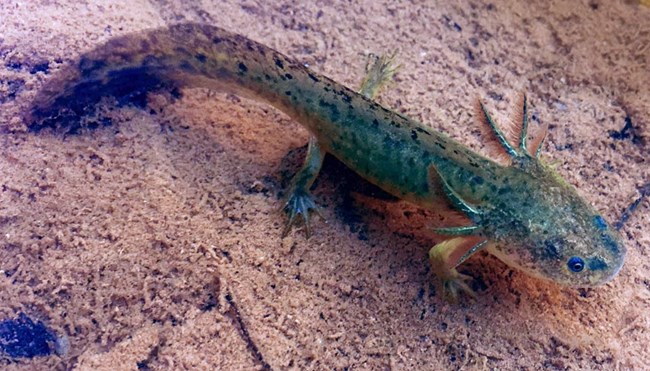
NPS/Paula Messing
Aquatic Features
Very little aquatic activity is noted except tadpoles and tiger salamanders. There are no fish. Macroinvertebrates are monitored four times a year as part of the water quality monitoring program started in 1997.
Unique Features and Species of Special Concern
Plants
The rare kachina daisy (Erigeron kachinensis) is found in Natural Bridges National Monument. This species was first described from Natural Bridges and is uncommon throughout its range. The kachina daisy exists in several moist alcoves associated with hanging garden communities and has been the subject of extensive research. It is endemic to San Juan County, Utah, and Montrose County, Colorado, and has been recommended for high priority species-level management.
Animals
Peregrine falcon (Falco peregrinus) has been delisted but is still of concern. A breeding pair has nested successfully since 1993. The aerie location has changed each breeding season, but has remained within a discrete area. The threatened Mexican spotted owl (Strix occidentalis mexicana) is known to occur in similar habitats near the monument, but surveys have not revealed their presence here. A pair of northern goshawks (Accipter gentilis) nested in the monument in 1998.
Resource Management Concerns
Increased visitation, trespass livestock, and exotic plant species are resource management concerns.
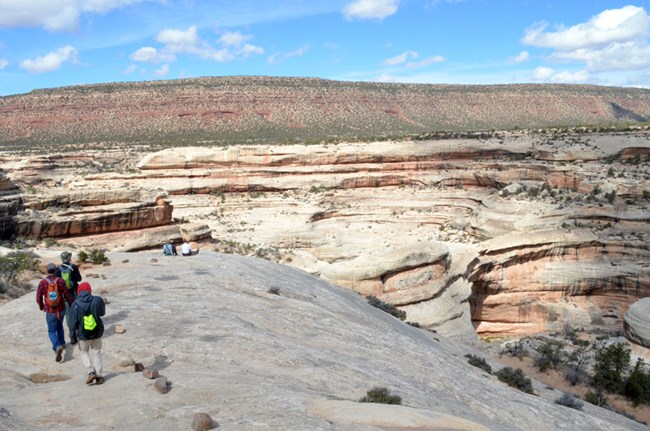
NPS/Austin Tumas
Recreation Use
Visitor use increased rapidly during the 1980s and early 1990s, causing soil and vegetation damage in heavily used areas. Off-trail hiking destroys cryptobiotic soils and tramples vegetation, which increases erosion.
Land Use Impacts
Agricultural practices surrounding the monument, primarily livestock grazing, are a concern. Trespass cattle are a constant problem. While lands are withdrawn from mineral leasing, oil and gas leases exist on Bureau of Land Management lands within 3–5 kilometers (2–3 miles) of the boundary (though none are currently in production), and there is increasing potential for oil and gas development within White Canyon. Oil and gas development is an external threat to monument resources (clean air, night sky, solitude and wilderness).
Invasive Exotic Plant Species
About 40 exotic plant species, such as tamarisk, horehound, mint, and musk thistle, are found in the monument. The extent of spread has been minimized by staff, who make a concerted effort to control exotics through mechanical and chemical means.
Content was edited and formatted by E. Rendleman.
Last updated: June 27, 2025
